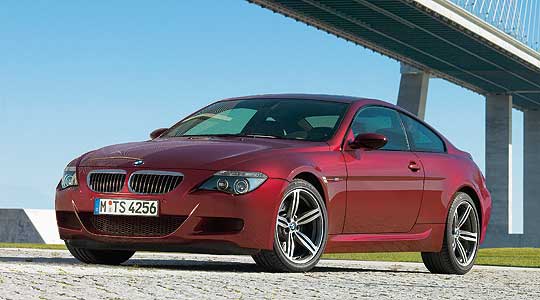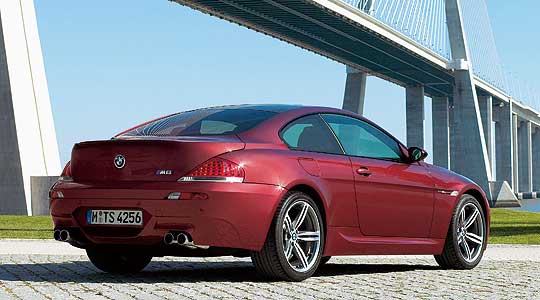
The announcement of a new M car remains a rare and exciting occasion, and the launch of the new M6 in 2005 will reveal a potent new combination of BMW engineering and M power. Hot on the heels of the new M5, and taking lightweight design solutions from the M3 CSL, the new M6 combines supercar presence with Grand Touring potential. Joining an exclusive club, the fourth new M car of the decade sets a new performance benchmark for a production car. The beauty of the M6 is also its ability to comfortably crush kilometres on a cross-country cruise.
Hot on the heels of the new M5, and taking lightweight design solutions from the M3 CSL, the new M6 combines supercar presence with Grand Touring potential. Joining an exclusive club, the fourth new M car of the decade sets a new performance benchmark for a production car. The beauty of the M6 is also its ability to comfortably crush kilometres on a cross-country cruise.

Like its predecessor - the legendary 1985 M635CSi – the new M6 resets the sports GT benchmark, with supercar performance, dispatching the zero to 62mph sprint in 4.6 seconds and achieving a limited top speed of 155mph. If derestricted, the M6 would be capable of a 200mph+ top speed. During tests at the famous Nürburgring Nordschleife circuit, the new M6 regularly clocked eight minutes lap times. These rarefied performance statistics are, however, backed up by ‘real world’ economy and efficiency - the new M6 delivers a combined EU fuel consumption of 19.0mpg and a CO2 rating of 357g/km.
Powered by the same 4,999cc engine that set new standards in the M5, the 507bhp power output ensures that the new M6 maintains the M car tradition of breaking the 100bhp per litre benchmark. Peak power is developed at 7,750rpm with the red line set at 8,250rpm. Peak torque of 520Nm is developed at 6,100rpm of which 450Nm is available from just 3,500rpm. The 90-degree V10 aluminium-silicon alloy engine block is extremely light yet robust and is the first V-arrangement engine to use a bedplate construction. The aluminium bedplate with cast-iron inlays ensures the engine’s rigidity throughout the rev range, but the complete unit still weighs just 240kg.
The capable chassis of the new M6 permits lateral acceleration in excess of 1g. To cope with such forces, the V10 engine features a lateral force-controlled oil supply that, from 0.6g of lateral movement, activates one of two electronic oil pumps to draw oil from the cylinder head and delivers it back into the sump to ensure perfect lubrication even in the most extreme situations. It is because of the extreme forces that can be induced by the M6 that the car also makes use of a semi dry sump lubrication system with an oil reservoir on each side of the front subframe.
Like the M5, the new M6 also uses BMW’s new third-generation seven speed Sequential Manual Gearbox (SMG) with Drivelogic. Drivelogic offers the choice of 11 different change patterns, depending on the speed of change required. Six change patterns are available in the manual mode and five in the ‘automatic’ mode, in which the gearbox will automatically select the most appropriate gear depending on driving conditions.
The suspension of the new M6 is based on the ‘standard’ 645Ci geometry. With the exception of components such as tie bars, wheel mounts and bearings, the double-arm spring strut front axle is made completely of aluminium. The U-shaped front subframe houses the rack and pinion steering assembly, anti-roll bar and track control arms.
The new BMW M6 comes with a Power button (pioneered in the M5) in the centre console. Initially the car pre-selects the P400 setting, delivering 400bhp for town or city driving, for example. Engaging the Power button modifies the response of the throttle and enables the P500 setting to deliver the full 507bhp generated by the V10 engine.
For a car with such potential, high performance brakes are needed and the new BMW M6 doesn’t disappoint. Using aluminium double piston callipers and cross-drilled disc brakes, the car can stop from 62mph in just 36 metres and from 124mph (200km/h) in only 140 metres – equivalent to 1.3g deceleration.
Specially developed tyres ensure that the prodigious horsepower and braking power are transferred to the road. Measuring 255/40ZR19 on the front and 285/35ZR19 on the rear, the tyres are mounted on lightweight five-spoke 19-inch forged aluminium wheels, each weighing 1.8kg less than a normal cast alloy wheel.
Visually, the new M6 differentiates itself from the 6 Series by a deeper front valance with air intakes for the engine and brakes, more contoured sills and rear valance that includes a diffuser to increase aerodynamic efficiency. Nestling under the rear valance are BMW M’s telltale four rear exhaust pipes. To complement the changes in body styling, the new M6 is available in four exclusive M colours – Indianapolis Red, Sepang Bronze, Interlagos Blue and Silverstone alongside three other 6 Series colours.
Inside, the new M6 comes with fully adjustable M sports seats that include lumbar support and an adjustable backrest width as standard. They are covered in extended Merino leather, with the owner able to choose between Black, Silverstone or Sepang. As an option, full Merino leather can be specified in Indianapolis Red and Portland Natural Brown alongside the other three colours that includes a leather covered dashboard and Alcantara headlining.
The new BMW M6 also features BMW M’s version of the new Head-up Display system. Unlike the standard Head-up Display available on 5 and 6 Series models that offers navigation instructions and cruise control information, the system on the M6 projects driver-focussed information such as engine speed, gear selected and road speed directly into the driver’s view, obviating the need for the driver to take his or her eyes off the road ahead.
The new M6 will go on sale towards the end of 2005. Dates and prices will be announced in due course.
Text/Photos: BMW
ClassicInside - The Classic Driver Newsletter
Free Subscription!


